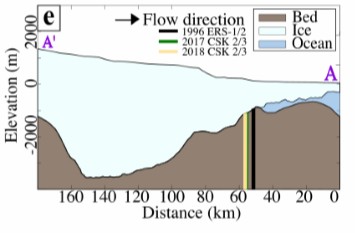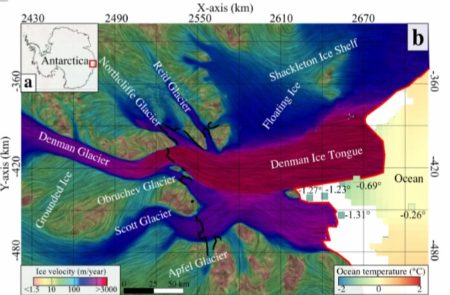March 24, 2020 – In the last few weeks, scientists have given us an update on the amount of polar ice loss that is been underway since the 1990s. Between Greenland and Antarctica, the total amounts to 6.4 trillion tons from 1992 to 2017. This is not good news for coastal communities around the world as sea levels rise faster than at any time since we began keeping records going back to the 19th century. The amount of ice loss is mirroring the worst expectations in recent Intergovernmental Panel on Climate Change (IPCC) reports. Should the trend continue through the remainder of the century it will mean more than 400 million people living on continental margins will be at risk to ocean inundations and that means if you are urban planners build those sea walls sooner than later. The combined contribution of Greenland and Antarctica’s rate of melting amounts to a sea-level rise of 17.8 millimeters (0.70 inches).
East Antarctica of late has become an interesting contributor to our understanding of continental ice melt. In particular, the Denman Glacier which contains enough ice to raise sea levels 1.5 meters (almost 5 feet) sits atop an Antarctic land basin that at its deepest point is 3.4 kilometers (2.1 miles) below sea level. Since 1979 the glacier has retreated more than 4.8 kilometers (3 miles) and lost 268 billion tons of mass. As it melts, the subsurface melt from the Denman can flow in two directions. Some can go into the Southern Ocean surrounding Antarctica, while the rest can flow downhill into the ice-covered canyon that lies beneath the glacier.

This unusual circumstance has become a concern for glaciologists and climatologists who recognize that the melting in two directions will lead to the opening of a passage for the water of the Southern Ocean to flow under the glacier inland. It’s not if but when this happens, the Denman could experience a dramatic and irreversible retreat.
Studies of the Southern Ocean that sits along the edges of the Atlantic, Pacific, and Indian Oceans, has been absorbing heat from the atmosphere at an accelerated rate. In fact, research shows that since 2006 the majority of global ocean heat content related to atmospheric warming is in the Southern Ocean. That warming is not distributed equally throughout the water column. For example, the upper 1,000 meters (3,280 feet) of the Southern Ocean on the fringe of its neighbouring oceans have warmed at a rate of between 0.1 and 0.2 Celsius (0.18 to – 0.36 Fahrenheit) per decade since 2006. Surface waters of the Southern Ocean further to the south, in contrast, have been cooling slightly while water along the seafloor, known as abyssal water, abutting the Antarctic continental shelf have been warming at a rate of 0.05 Celsius (0.09 Fahrenheit) per decade over the same period.
It is not known whether what is being observed is a multidecadal variability, but there appears to be a strong correlation between increasing ocean heat content, and atmospheric warming above Antarctica and its surrounding seas.
To illustrate, in February of this year, Argentina’s Marambio research station, on an island off the Antarctic Peninsula, recorded a daytime high of 20.75 Celsius (69.35 Fahrenheit), the first time the continent experienced an above 20 Celsius daytime temperature. This occurred in an area considered to be the fastest-warming place on Earth with average temperatures 3 Celsius (5.4 Fahrenheit) higher than 50 years ago. Compare that to the overall warming of the planet at 0.8 Celsius and we are talking about a 375% greater mean rate of warming.
If the warming of both atmosphere and ocean continues then the retrograde bed of the Denman is likely to be the place where we will witness the first major collapse of a 24,000 square kilometer (9,266 square mile) ice sheet. NASA-scientist, Virginia Brancato, who has been studying the Denman, describes it as “the most vulnerable spot” in East Antarctica.
Even more troubling is the fact that scientists until recently thought of West Antarctica as the unstable part of the continent. It turns out that ice instability today is consistent across the entirety of the southern continent.
















